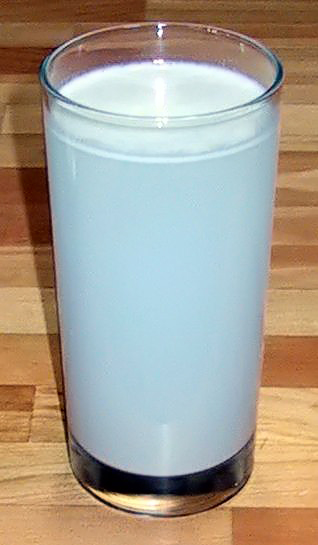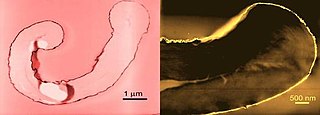Academic career
This section of a biography of a living person needs additional citations for verification .(January 2024) |
Texter joined the College of Engineering and Technology of Eastern Michigan University in the fall of 2002 as a professor of polymer and coating technology at the rank of full professor. In 2005 he was awarded tenure. Since joining EMU, he has also been a Coatings Research Institute [16] faculty member. He spent a sabbatical year near Berlin as a Fellow of the Max Planck Society with Professor Markus Antionetti at the Max Planck Institute of Colloids and Interfaces.
His research has focused on small particle science and technology, the development of particle-based advanced materials, and polymeric advanced materials. His work has focused on applied problems in dispersion and materials technology for advanced coatings in imaging, antifouling, corrosion mitigation, and antimicrobial prophylaxis. He has made significant contributions to the understanding of microemulsion structure and the complex equilibria that exist among the exotic molecular complexes contained in microemulsions, as well as in microemulsion polymerization.[ citation needed ]
In more recent years, he has become a leading innovator in the fields of stimuli-responsive polymers (smart polymers) and polymerized ionic liquids.[ citation needed ]
In August 2021, he resigned his tenure and was named professor emeritus by the EMU Board of Regents on 9 December 2021.[ citation needed ]
Highlights of Research Accomplishments:
2014–present Advanced understanding and experimental application of liquid-phase exfoliation of 2D materials (graphene, black phosphorus, MoS2, ...) – Derived analytical kinetic model for 2D exfoliation in dispersion – Showed graphene dispersions to be rheo-optical fluids that reversible undergo isotropic to nematic transitions under shear
2006–present Third international lab (after Ohno in Japan and Mecerreyes in Spain) to help initiate polymerized ionic liquids (PIL) research with introduction of reversibly-porating gels based on pinned spinodal decomposition and nanolatex syntheses by microemulsion polymerization – Demonstrated such materials provide osmotic brush stabilization when used in dispersions as dispersing aids – Showed that such PIL materials, particularly nanolatexes, exhibit a dynamic range greater than 104-fold in stability based on anion exchange or solvent exchange – Illustrated that these stability phenomena are basis of stimuli responsive behaviors including polymer-poration, swelling, phase transfer in addition to dispersion stability – Showed how nanocarbons, such as SWCNT, MWCNT, and graphene, can be dispersed in water at concentrations of 1-17% by weight, eclipsing leading international labs by 100-fold – Applied ATRP controlled polymerization to make new class of triblock copolymers with PIL blocks that form thermoreversible gels – Developed diblock copolymers, poly(PNIPAM-b-PIL), that reversibly precipitate as ultrastable (in boiling water) nanoparticles when heated
2004–present Extended invention of solvent-free nanofluids, nanoparticles that form moderate to high viscosity liquids at room temperature in absence of any added solvent, by Giannelis, [17] Archer, [18] Wiesner [19] groups at Cornell to create reactive solvent-free nanofluids to create new resins and materials and exotic cross-linking agents in photoinitiated UV (free radical), polyurethane, and polyurea (air curing) systems – Demonstrated applications in producing UV-protective overcoats, new adhesives and sealants, and lubricants – Showed that such liquid colloids can be used to mitigate brittleness and increase toughness induced by nanofillers in nanocomposites – Developed core-free solvent-free nanofluids derived from organo-trialkoxysilanes that, because of high polydispersity, provided first experimental examples of coexistence of multiple phase domains due to polydispersity – Showed that such glass transition and melting in such core-free nanofluids are lambda transitions and second-order (continuous) phase transitions – Presented reactive nanofluids as additive manufacturing inks (featured in C&E News)
1992-2013 Formulated first anionically stabilized microemulsion polymerization system without using cosurfactants, foundational to field of microemulsion polymerization – Advanced understanding of microemulsions and microemulsion polymerization by experimentally deriving an order parameter-based proof that swollen-micelle to bicontinuous to swollen-reverse-micelle transitions are continuous (second order) phase transitions – Demonstrated how to capture bicontinuous microemulsion structure by using neutron scattering to characterize microemulsion and resulting polymeric gel
1990-2008 Contributed to development of electroacoustic sonic amplitude (ESA) as practical method of characterizing electrokinetics in concentrated dispersions by developing calibration methods to translate measurements to electrophoretic mobilities – Showed that time-dependent dielectric reflectance spectroscopy (TDS) could derive electrophoretic mobilities of particulates in presence of indifferent electrolyte – Applied TDS to characterize microemulsion second-order phase transitions and percolation in microemulsions – Showed that dielectric spectroscopy could quantify electronic and ionic conductivities in coatings of colloids and gels
1977-1986 Demonstrated creation of zeolite supported colloidal copper and silver clusters by thermal and chemical reduction chemistries – Documented electronic Jahn-Teller splitting of UV silver ion multiplet spectra in zeolites – First experimental demonstration of electronic-spectral Dewar-Chatt effect (Dewar–Chatt–Duncanson model) in charged silver clusters using reversible ethylene and butylene adsorption-desorption








